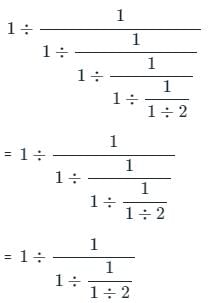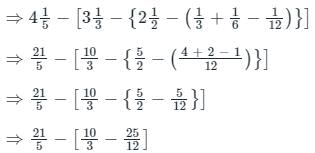All Exams >
JAMB >
Mathematics for JAMB >
All Questions
All questions of Fractions, Decimals and Approximations for JAMB Exam
 then the value of
then the value of 
- a)0.2689
- b)2689
- c)2.689
- d)26890
Correct answer is option 'B'. Can you explain this answer?
 then the value of
then the value of 
a)
0.2689
b)
2689
c)
2.689
d)
26890

|
Sun Ray Institute answered |
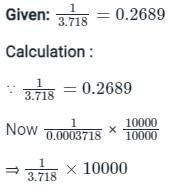
⇒ 0.2689 × 10000
⇒ 2689
Hence the correct answer is "2689".
What should come in place of question mark ‘?’ in the following question?0.36 of 52.5 + ? of 35 = 57.4- a)1.01
- b)1.21
- c)1.16
- d)1.10
Correct answer is option 'D'. Can you explain this answer?
What should come in place of question mark ‘?’ in the following question?
0.36 of 52.5 + ? of 35 = 57.4
a)
1.01
b)
1.21
c)
1.16
d)
1.10

|
Sun Ray Institute answered |
0.36 of 52.5 + ? of 35 = 57.4
⇒ 18.9 + ? of 35 = 57.4
⇒ ? of 35 = (57.4 − 18.9)
⇒ ? = 38.5/35
⇒ ? = 1.1
What is the value of  on simplification?
on simplification?- a)22.5
- b)15.3
- c)153
- d)459
Correct answer is option 'C'. Can you explain this answer?
What is the value of  on simplification?
on simplification?
 on simplification?
on simplification?a)
22.5
b)
15.3
c)
153
d)
459

|
Sun Ray Institute answered |
Given:

Calculations:
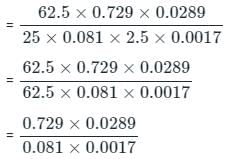
= 9 × 17
=153

Calculations:

= 9 × 17
=153
What will come in the place of the question mark ‘?’ in the following question?

- a)10
- b)13
- c)12
- d)30
Correct answer is option 'D'. Can you explain this answer?
What will come in the place of the question mark ‘?’ in the following question?


a)
10
b)
13
c)
12
d)
30

|
Sun Ray Institute answered |

⇒ (13/5) × (45/26) × (20/3) = ?
⇒ (9/2) × (20/3) = ?
⇒ 3 × 10 = ?
⇒ ? = 30
Read the following facts:A decimal number refers to any number written in the decimal system. Our decimal system allows us to write numbers of all kinds and sizes using a clever symbol called a decimal point. As you move to the right of the decimal point, each place value is divided by 10.Find the largest decimal number from the options below.- a)18.001
- b)18.8
- c)18.08
- d)18.009
Correct answer is option 'B'. Can you explain this answer?
Read the following facts:
A decimal number refers to any number written in the decimal system. Our decimal system allows us to write numbers of all kinds and sizes using a clever symbol called a decimal point. As you move to the right of the decimal point, each place value is divided by 10.
Find the largest decimal number from the options below.
a)
18.001
b)
18.8
c)
18.08
d)
18.009

|
Sun Ray Institute answered |
Given:
Largest decimal number.
Calculations:
From the given facts, 18.8 is the largest decimal number out of rest given options as, in the rest three options after the decimal point there are zeros making the number smaller than 18.8
∴ The answer is 18.8.

- a)2.5
- b)0.25
- c)0.0025
- d)0.025
Correct answer is option 'D'. Can you explain this answer?

a)
2.5
b)
0.25
c)
0.0025
d)
0.025

|
Sun Ray Institute answered |
Mistake Points:
In this type of question, in the numerator, there are 6.75 and 4.25, while in the denominator there is 67.5, and 42.5 is present in multiplication.
From the denominator, we can write 67.5 × 67.5 as 6.75 × 10 × 6.75 × 10 = 100 × (6.75), and similarly for other terms.
Therefore we take 100 as common from the denominator.
Identity used:
a3 - b3 = (a - b) (a2 + b2 + ab)
Calculation:


⇒ ? = 2.5/100
⇒ ? = 0.025
∴ ? = 0.025

- a)11/7
- b)2
- c)4/7
- d)7/11
Correct answer is option 'A'. Can you explain this answer?

a)
11/7
b)
2
c)
4/7
d)
7/11

|
Sun Ray Institute answered |
Given:

Calculation:

Calculation:
On picking fractions one by one,
⇒ 1 - 1/2 = 1/2
⇒ 2 + 1 = 3
⇒ 1 + 1/3 = 4/3
⇒ 1 + 4/3 = 7/4
⇒ 1 + 4/7 = 11/7
Solve:(?)3 × 10 = 13230 ÷ (9.261 ÷ 7)- a)10
- b)25
- c)125
- d)0.5
Correct answer is option 'A'. Can you explain this answer?
Solve:
(?)3 × 10 = 13230 ÷ (9.261 ÷ 7)
a)
10
b)
25
c)
125
d)
0.5

|
Sun Ray Institute answered |
Given expression is,
⇒ (?)3 × 10 = 13230 ÷ (9.261 ÷ 7)
⇒ (?)3 × 10 = 13230 ÷ (1.323)
⇒ (?)3 × 10 = 10000
⇒ (?)3 = 1000
⇒ (?)3 = (10)3
⇒ ? = 10
The closest approximation of the solution product
0.3333 × 0.25 × 0.499 × 0.125 × 24 is:- a)1/8
- b)3/4
- c)3/8
- d)2/5
Correct answer is option 'A'. Can you explain this answer?
The closest approximation of the solution product
0.3333 × 0.25 × 0.499 × 0.125 × 24 is:
0.3333 × 0.25 × 0.499 × 0.125 × 24 is:
a)
1/8
b)
3/4
c)
3/8
d)
2/5

|
Sun Ray Institute answered |
0.3333 × 0.25 × 0.499 × 0.125 × 24
⇒ 1 / 3 × 1 / 4 × 499/1000 × 1/8 × 24
⇒ 1 /3 × 1 / 4 × 499 / 1000 × 3
⇒ 1 / 4 × 499 / 1000
⇒ 499/4000
⇒ 0.12475 ~ 0.125
⇒ 0.125 = 1/8
Hence the correct answer is "1/8".
In a group of students, 1/5 are aged below 8 years. Of the remaining 2/5 are above 8 years. What fraction of the students are exactly 8 years of age?- a)12/25
- b)2/5
- c)3/5
- d)4/25
Correct answer is option 'A'. Can you explain this answer?
In a group of students, 1/5 are aged below 8 years. Of the remaining 2/5 are above 8 years. What fraction of the students are exactly 8 years of age?
a)
12/25
b)
2/5
c)
3/5
d)
4/25

|
Sun Ray Institute answered |
Let the total number of students in the group be 1
Number of students who are below age 8 = 1 × 1/5 = 1/5
Remaining students = 1 – 1/5 = 4/5
Number of students who are above age 8 = 4/5 × 2/5 = 8/25
Number of students who are exactly 8 years old = 1 – 1/5 – 8/25 = 12/25
Short trick:
Let the total number of students be 25
Number of student who are below age 8 = 25 × 1/5 = 5
Remaining students = 25 – 5 = 20
Number of students who are above age 8 = 20 × 2/5 = 8
Number of students who are exactly age 8 = 25 – 5 – 8 = 12
Required fraction = 12/25
The sum of all proper fractions whose denominators are less than or equal to 100 is:- a)2124
- b)2475
- c)2575
- d)1925
Correct answer is option 'B'. Can you explain this answer?
The sum of all proper fractions whose denominators are less than or equal to 100 is:
a)
2124
b)
2475
c)
2575
d)
1925

|
Sun Ray Institute answered |
Formula used :
(1 + 2 + 3 + 4 + ......... + 99) = [ n ( n + 1 ) ] ÷ 2
Solution :
We can write all proper fractions whose denominators are less than or equal to 100 in given form :
⇒ 1/2 + (1/3 + 2/3) + (1/4 + 2/4 + 3/4) + ... (1/100 + 2/100 + .. .. 99/100)
⇒ 1/2 + 3/3 + 6/4 + ..... + 4950/100
⇒ 1/2 + 1 + 3/2 + 2 + ........ + 99/2
We can also write this equation in following way :
⇒ 1/2 + 2/2 + 3/2 + ...... + 99/2
⇒ 1/2 ( 1 + 2 + 3 + ..... + 99 )
⇒ /2 [ ( 99 × 100) ÷ 2 ]
⇒ 99 × 25
⇒ 2475
Hence the correct answer is "2475".
Which of the following is true?- a)9/16 < 13/24
- b)9/16 = 13/24
- c)9/16 > 13/24
- d)9/16 ≤ 13/24
Correct answer is option 'C'. Can you explain this answer?
Which of the following is true?
a)
9/16 < 13/24
b)
9/16 = 13/24
c)
9/16 > 13/24
d)
9/16 ≤ 13/24

|
Sun Ray Institute answered |
Concept Used:
a/b and c/d are two numbers,
then (a × d) and (b × c) are need to be compared.
Calculation:
We have, 9/16 and 13/24
⇒ 9 × 24 = 216
⇒ 13 × 16 = 208
⇒ 216 > 208
⇒ 9/16 > 13/24.
Which of the following fractions is the largest?- a)13/19
- b)25/31
- c)28/31
- d)70/79
Correct answer is option 'C'. Can you explain this answer?
Which of the following fractions is the largest?
a)
13/19
b)
25/31
c)
28/31
d)
70/79

|
Sun Ray Institute answered |
Given:
The fractions are 13/19, 25/ 31, 28/31, 70/79.
Calculation:
The values are-
13/19 = 0.68
25/31 = 0.80
28/31 = 0.90
70/79 = 0.88
∴ Option C is correct.
 then the value of x is
then the value of x is- a)1/3
- b)1
- c)2/3
- d)None of the above
Correct answer is option 'C'. Can you explain this answer?
 then the value of x is
then the value of x isa)
1/3
b)
1
c)
2/3
d)
None of the above

|
Sun Ray Institute answered |
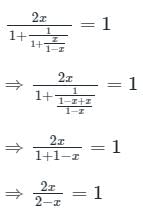
⇒ 2x = 2 - x
⇒ 3x = 2
⇒ x = 2/3
∴ The value of x is 2/3
The correct option is 3 i.e. 2/3
What value should come in the place of the question mark (?) in the following equation?(0.009 ÷ ?) + (0.007 ÷ 0.07) + (0.04 ÷ 0.4) = 0.3- a)0.001
- b)0.09
- c)0.009
- d)0.9
Correct answer is option 'B'. Can you explain this answer?
What value should come in the place of the question mark (?) in the following equation?
(0.009 ÷ ?) + (0.007 ÷ 0.07) + (0.04 ÷ 0.4) = 0.3
a)
0.001
b)
0.09
c)
0.009
d)
0.9

|
Sun Ray Institute answered |
(0.009 ÷ ?) + (0.007 ÷ 0.07) + (0.04 ÷ 0.4) = 0.3


⇒ ? = 0.009 × 10
⇒ ? = 0.09
∴ The value of "?" is 0.09
What will come in place of question mark '?' in the following question?

- a)8
- b)9
- c)7
- d)6
Correct answer is option 'A'. Can you explain this answer?
What will come in place of question mark '?' in the following question?


a)
8
b)
9
c)
7
d)
6

|
Sun Ray Institute answered |
Given expression is,
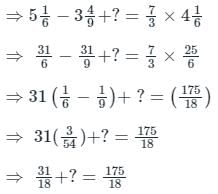

⇒ ? = 144/18
⇒ ? = 8
Directions: What will come in place of the question mark (?) in the following questions?? = {(2.5)3 + (1.5)3}/{(2.5)3 – (1.5)3}- a)3/5
- b)6233/2000
- c)6233/1000
- d)
- 76/49
Correct answer is option 'D'. Can you explain this answer?
Directions: What will come in place of the question mark (?) in the following questions?
? = {(2.5)3 + (1.5)3}/{(2.5)3 – (1.5)3}
a)
3/5
b)
6233/2000
c)
6233/1000
d)
- 76/49

|
Sun Ray Institute answered |
Given:
{(2.5)3 + (1.5)3}/{(2.5)3 – (1.5)3}
Calculation:
⇒ ? = {(2.5)3 + (1.5)3}/{(2.5)3 – (1.5)3}
⇒ ? = (15.625 + 3.375)/(15.625 - 3.375)
⇒ ? = 19/12.25
⇒ ? = 1900/1225 = 76/49
Solve:(81.84 + 118.16) ÷ 53 = 1.2 × 2 + ?- a)0.8
- b)-0.8
- c)0.6
- d)-0.6
Correct answer is option 'B'. Can you explain this answer?
Solve:
(81.84 + 118.16) ÷ 53 = 1.2 × 2 + ?
a)
0.8
b)
-0.8
c)
0.6
d)
-0.6

|
Sun Ray Institute answered |
Given expression,
(81.84 + 118.16) ÷ 53 = 1.2 × 2 + ?
⇒ 200 ÷ 53 = 1.2 × 2 + ?
⇒ 200 ÷ 125 = 1.2 × 2 +?
⇒ 1.6 = 2.4 + ?
⇒ ? = -0.8
What approximate value should come in place of question mark ‘?’ in the following question?1132.757 – 2315.996 – 1753.829 + 2 × 2846.639 = ?- a)2746
- b)2757
- c)2656
- d)2646
Correct answer is option 'B'. Can you explain this answer?
What approximate value should come in place of question mark ‘?’ in the following question?
1132.757 – 2315.996 – 1753.829 + 2 × 2846.639 = ?
a)
2746
b)
2757
c)
2656
d)
2646

|
Sun Ray Institute answered |
1132.757 – 2315.996 – 1753.829 + 2 × 2846.639
= 1133 – 2316 – 1754 + 5694
= (1133 + 5694) – (2316 + 1754 )
= 6827 – 4070
= 2757
If the fractions 7/13, 2/3, 4/11, 5/9 are arranged in ascending order, then the correct sequence is?- a)2/3, 7/13, 4/11, 5/9
- b)7/13, 4/11, 5/9, 2/3
- c)4/11, 7/13, 5/9, 2/3
- d)5/9, 4/11, 7/13, 2/3
Correct answer is option 'C'. Can you explain this answer?
If the fractions 7/13, 2/3, 4/11, 5/9 are arranged in ascending order, then the correct sequence is?
a)
2/3, 7/13, 4/11, 5/9
b)
7/13, 4/11, 5/9, 2/3
c)
4/11, 7/13, 5/9, 2/3
d)
5/9, 4/11, 7/13, 2/3

|
Sun Ray Institute answered |
(7/13) = 0.538
(2/3) = 0.666
(4/11) = 0.3636
(5/9) = 0.5555
Out of 2/3, 7/13, 4/11, 5/9
2/3 is the largest number followed by 5/9 then 7/13 and the smallest is 4/11.
∴ The ascending order will be 4/11, 7/13, 5/9, 2/3.
The positive square root of

- a)3
- b)4
- c)1
- d)2
Correct answer is option 'D'. Can you explain this answer?
The positive square root of


a)
3
b)
4
c)
1
d)
2

|
Sun Ray Institute answered |

⇒ [ ( 0.75 × 0.75 × 0.75 ) / 0.25 ] + [ 1.75 + 0.5625 ]
⇒ [ ( 3 × 0.5625 ) ] + [ 2.3125 ]
⇒ [ 1.6875 + 2.3125 ]
⇒ 4
Now √4 = 2
Hence the correct answer is "2".
Correct expression of 
- a)1/55
- b)18/100
- c)18/1000
- d)1/66
Correct answer is option 'A'. Can you explain this answer?
Correct expression of 

a)
1/55
b)
18/100
c)
18/1000
d)
1/66

|
Sun Ray Institute answered |
Calculation:
Let x = 0.0181818....
⇒ 10x = 0.1818.... ----eq (1)
⇒ 1000x = 18.1818.... ----eq (2)
Now, eq (2) - eq (1)
⇒ 1000x - 10x = 18.1818... - 0.1818...
⇒ 990x = 18
⇒ x = 18/990
⇒ x = 1/55
∴ The fraction of is 1/55
is 1/55
∴ The fraction of
 is 1/55
is 1/55The value of  is equal to:
is equal to:- a)

- b)

- c)

- d)

Correct answer is option 'B'. Can you explain this answer?
The value of  is equal to:
is equal to:
 is equal to:
is equal to:a)

b)

c)

d)


|
Sun Ray Institute answered |
Formula used:

Calculation:

By using the above formula
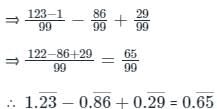

Calculation:

By using the above formula

Alternate Method
Calculation:

Calculation:

By subtracting eq.1 from eq.2:
99x = 122
⇒ x = 122/99


By subtracting eq.3 from eq.4:
99y = 86
⇒ y = 86/99


By subtracting eq.5 from eq.6:
99z = 29
⇒ z = 29/99
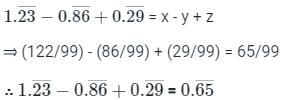

7/9 of the people present in a hall are sitting in 9/13 of the chairs available and the rest are standing. If there are 28 empty chairs, how many chairs would have been still empty if everyone in the hall was sitting?- a)15
- b)12
- c)18
- d)10
Correct answer is option 'D'. Can you explain this answer?
7/9 of the people present in a hall are sitting in 9/13 of the chairs available and the rest are standing. If there are 28 empty chairs, how many chairs would have been still empty if everyone in the hall was sitting?
a)
15
b)
12
c)
18
d)
10

|
Sun Ray Institute answered |
Let the number of people be x and number of the chair be y.
Number of available chair = y × (9/13) = 9y/13
Number of empty chair = y - (9y/13) = 4y/13
Given, Number of empty chairs = 28
According to the question
4y/13 = 28
y = 28 × (13/4) = 91
Total number of chairs = 91
Number of chairs in which people are sitting = 91 - 28 = 63
Number of people who sit = x × (7/9) = 7x/9
According to the question
7x/9 = 63
x = 63 × (9/7) = 81
Total number of people are = 81
Chairs would have been still empty if everyone in the hall was sitting = 91 - 81 = 10
What will come in place of question mark ‘?’ in the following question?

- a)1
- b)100
- c)0.1
- d)0.01
Correct answer is option 'A'. Can you explain this answer?
What will come in place of question mark ‘?’ in the following question?


a)
1
b)
100
c)
0.1
d)
0.01

|
Sun Ray Institute answered |
Given:


Concept used:
a2 - b2 = (a + b) × (a - b)
Calculation:
⇒ [(4.22 - 1.92) + 2.3]/(2.3 × 7.1) = ?
⇒ [(4.2 + 1.9) × (4.2 - 1.9) + 2.3]/((2.3 × 7.1) = ?
⇒ (2.3 × 6.1 + 2.3)/(2.3 × 7.1) = ?
⇒ 2.3 × (6.1 + 1)/(2.3 × 7.1) = ?
⇒ (2.3 × 7.1)/(2.3 × 7.1) = ?
? = 1
On simplification  reduces to
reduces to- a)0.63
- b)0.65
- c)0.54
- d)None of these
Correct answer is option 'A'. Can you explain this answer?
On simplification  reduces to
reduces to
 reduces to
reduces toa)
0.63
b)
0.65
c)
0.54
d)
None of these

|
Sun Ray Institute answered |

Since,
a2 - b2 = (a - b) ( a + b)

⇒ 0.9 × 0.7 = 0.63
∴ Answer is 0.63
What is the value of 
- a)36
- b)37
- c)39
- d)38
Correct answer is option 'B'. Can you explain this answer?
What is the value of 

a)
36
b)
37
c)
39
d)
38

|
Sun Ray Institute answered |

= 25/2 + 37/3 + 73/6
= (75 + 74 + 73)/6
= 222/6
= 37
Shortcut Trick:

= 12 + 12 + 12 + (1/2 + 1/3 + 1/6)

= 12 + 12 + 12 + (1/2 + 1/3 + 1/6)
= 36 + 1 = 37
Find the value of {(.98)3 + (0.02)3 + 3 × 0.98 × 0.02 – 1}- a)1.98
- b)1.09
- c)1.562
- d)0
Correct answer is option 'D'. Can you explain this answer?
Find the value of {(.98)3 + (0.02)3 + 3 × 0.98 × 0.02 – 1}
a)
1.98
b)
1.09
c)
1.562
d)
0

|
Sun Ray Institute answered |
Given:
{(.98)3 + (0.02)3 + 3 × 0.98 × 0.02 – 1}
Concept used:
(a + b)3 = a3 + b3 + 3ab(a + b)
Calculation:
{(.98)3 + (0.02)3 + 3 × 0.98 × 0.02 – 1
⇒ [(.98)3 + (0.02)3 + 3 × 0.98 × 0.02(0.98 + 0.02)} – 1]
Now, first term is of the form (a + b)3 where a = .98 and b = 0.02
⇒ (0.98 + 0.02)3 – 1 = 1 – 1 = 0
∴ The value is 0.
Chapter doubts & questions for Fractions, Decimals and Approximations - Mathematics for JAMB 2025 is part of JAMB exam preparation. The chapters have been prepared according to the JAMB exam syllabus. The Chapter doubts & questions, notes, tests & MCQs are made for JAMB 2025 Exam. Find important definitions, questions, notes, meanings, examples, exercises, MCQs and online tests here.
Chapter doubts & questions of Fractions, Decimals and Approximations - Mathematics for JAMB in English & Hindi are available as part of JAMB exam.
Download more important topics, notes, lectures and mock test series for JAMB Exam by signing up for free.
Mathematics for JAMB
134 videos|94 docs|102 tests
|

Contact Support
Our team is online on weekdays between 10 AM - 7 PM
Typical reply within 3 hours
|
Free Exam Preparation
at your Fingertips!
Access Free Study Material - Test Series, Structured Courses, Free Videos & Study Notes and Prepare for Your Exam With Ease

 Join the 10M+ students on EduRev
Join the 10M+ students on EduRev
|

|
Create your account for free
OR
Forgot Password
OR
Signup to see your scores
go up
within 7 days!
within 7 days!
Takes less than 10 seconds to signup


